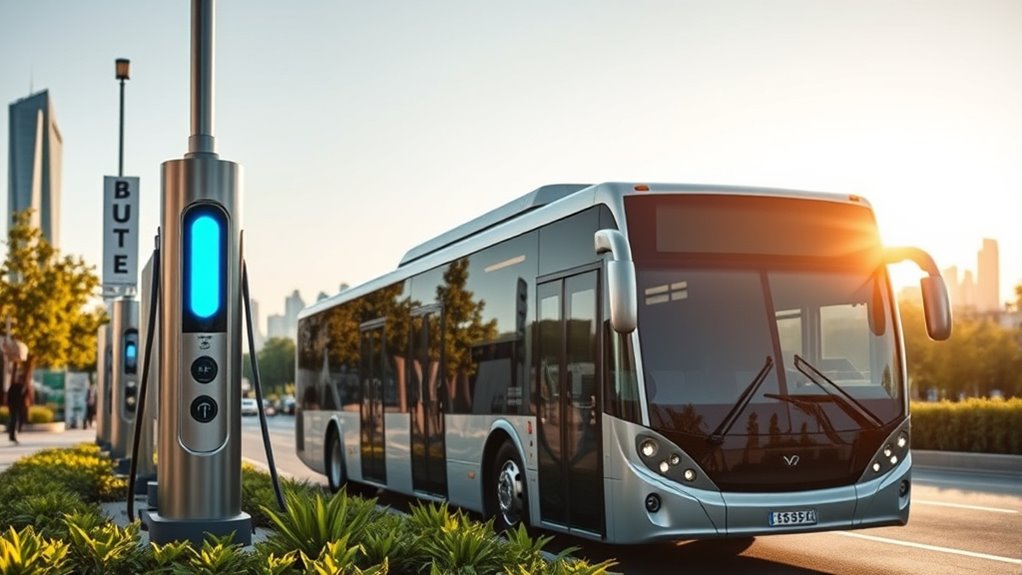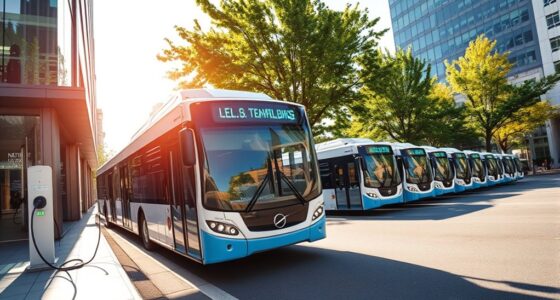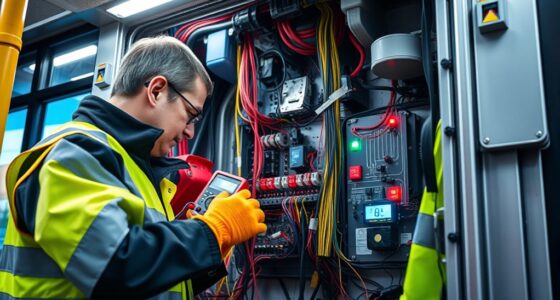To find the best charging stations for your electric bus, you need to consider the type of infrastructure that fits your fleet’s needs, such as depot, fast, or on-route chargers. Assess your operational schedule, route length, and grid capacity to plan station locations that maximize efficiency and reliability. Proper site layout and electrical upgrades ensure smooth operation without disruptions. Continue exploring to discover how to choose, design, and integrate charging stations effectively.
Key Takeaways
- Assess your bus fleet’s operational routes and charging needs to determine suitable infrastructure types and station locations.
- Choose appropriate charging technologies (Depot, DC fast, on-route) based on bus schedules, turnaround times, and power availability.
- Evaluate site accessibility, space, and electrical grid capacity to ensure efficient, future-proof station placement.
- Optimize station layout by combining equipment, managing traffic flow, and ensuring safety for quick, seamless charging.
- Plan for phased installation, leverage cost-sharing options, and consider smart energy management to reduce expenses and operational downtime.
Understanding Different Types of Bus Charging Infrastructure
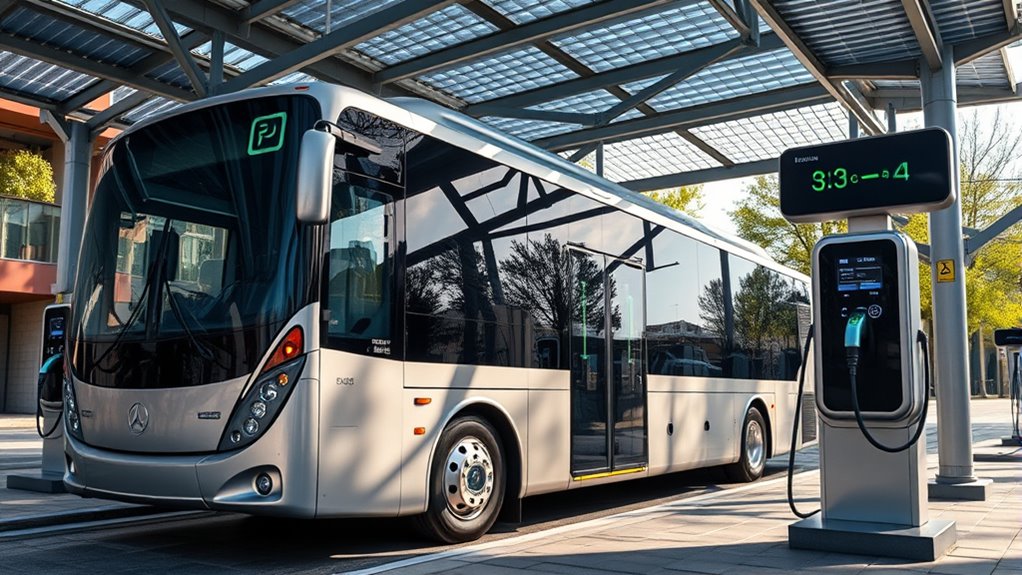
Understanding the different types of bus charging infrastructure is essential for selecting the right solution for your fleet’s needs. Depot plug-in charging is common for overnight use, where buses are parked and charged using standard connectors, often requiring significant power upgrades. This method benefits from proven reliability and is suitable for fleets with dedicated depots. DC distributed charging allows multiple buses to charge simultaneously with high-power chargers, typically taking 8 to 10 hours for a full charge. It offers increased efficiency for busy operations but requires substantial electrical infrastructure. Fast charging infrastructure provides high-power DC chargers—200 to 400 kW—enabling a bus to recharge in just 3 to 4 hours, ideal for quick turnarounds and minimizing downtime. On-route charging uses overhead pantographs, supporting a 2 to 3-hour charge along routes, but demands substantial infrastructure and power. Inductive charging employs in-ground pads to wirelessly transfer energy, offering low maintenance but still developing in adoption. Understanding the different types of bus charging infrastructure is crucial for optimal deployment and operational efficiency, especially considering the power requirements that influence infrastructure design and capacity planning.
Essential Components of a Charging Station
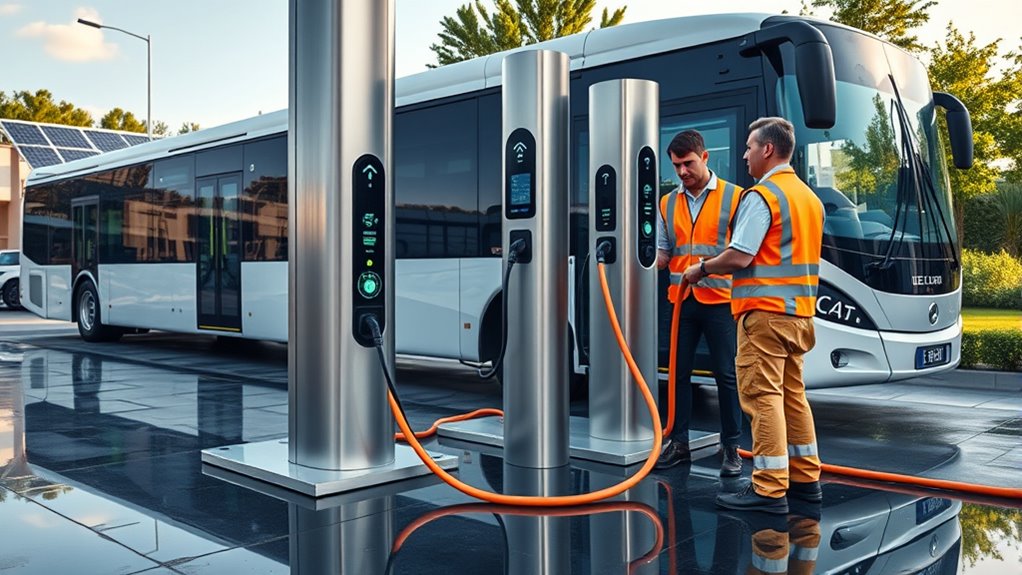
A charging station for electric buses comprises several essential hardware components that work together to guarantee efficient and safe operation. The core includes chargers that convert AC grid power into DC for battery charging, ranging from Level 2 to high-power DC fast chargers.
Charging ports serve as the interface between the charger and bus, either co-located or separated by site layout.
Power distribution equipment, such as transformers and circuit breakers, manages voltage and current flow, ensuring safety.
Meters track electricity consumption, with separate meters recommended for fleet management.
Cables and connectors, like CCS or pantograph interfaces, deliver power to buses reliably.
These components, combined with electrical infrastructure and safety systems, form the backbone of a well-functioning charging station.
Assessing Your Fleet’s Charging Needs and Planning Accordingly
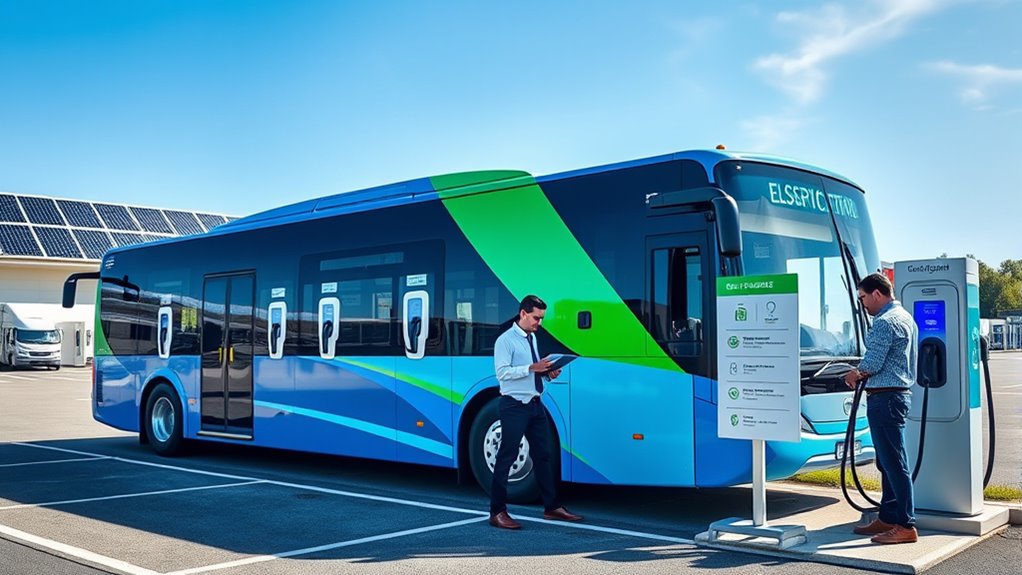
Evaluating your fleet’s charging needs is a vital first step in designing an effective electric bus infrastructure. You need to consider operational demands like route lengths and the number of buses in use, which directly influence charging frequency and capacity. Incorporating Mazda Tuning principles such as performance optimization can be adapted to improve charging strategies and overall system efficiency. Site capacity is also crucial; assess whether electrical service upgrades or demand charge reductions are needed. Understanding vehicle efficiency helps optimize charging schedules to minimize energy use. Additionally, understanding the importance of contrast ratio and its impact on system performance can aid in selecting compatible charging hardware that ensures clear and reliable operation. Cost strategies like managed charging and smart scheduling can lower peak loads and reduce expenses. Implementing power management systems can further enhance energy distribution and prevent overloads during peak times. Considering the nutritional value of juices and how it relates to energy input can inform sustainable energy planning for charging stations, ensuring the system remains efficient and eco-friendly. Decide between depot charging or en-route solutions based on operational patterns.
Designing Efficient and Accessible Charging Station Layouts
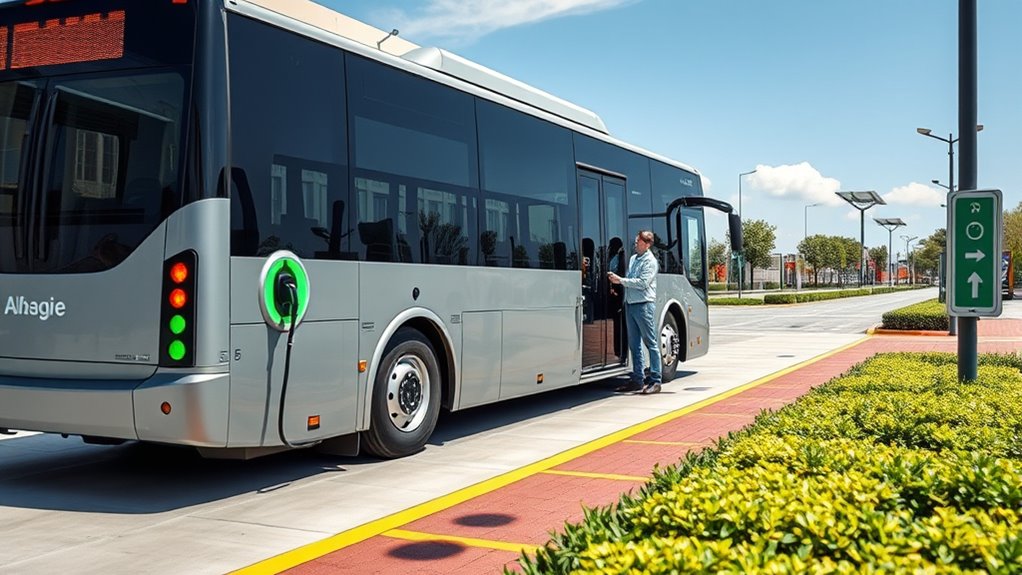
Designing an efficient and accessible charging station layout requires careful planning to optimize space and guarantee smooth vehicle movement. You should prioritize space-efficient solutions like compact chargers and gantry-mounted systems, especially in urban areas with limited space. Combining equipment into fewer structures, such as power cabinets, helps reduce footprint. Additionally, considering the forsale 100 market trends can help determine the most cost-effective equipment options. Make certain your layout facilitates efficient traffic flow by strategically positioning lanes and chargers to minimize congestion and maximize turnover. Incorporating necessary cookies can ensure essential site functionalities remain operational during setup and maintenance. Incorporate safety regulations and emergency access considerations into your design. Understanding the health benefits of juice can also inspire environmentally friendly energy solutions for your station, promoting sustainability. Integrate software controls to automate operations and improve throughput. Proper site selection and preparation, including evaluating grid capacity and planning for future expansion, are essential.
A well-designed layout not only streamlines charging but also supports safety, adaptability, and long-term operational efficiency.
Strategies to Maximize Charging Station Performance and Reliability
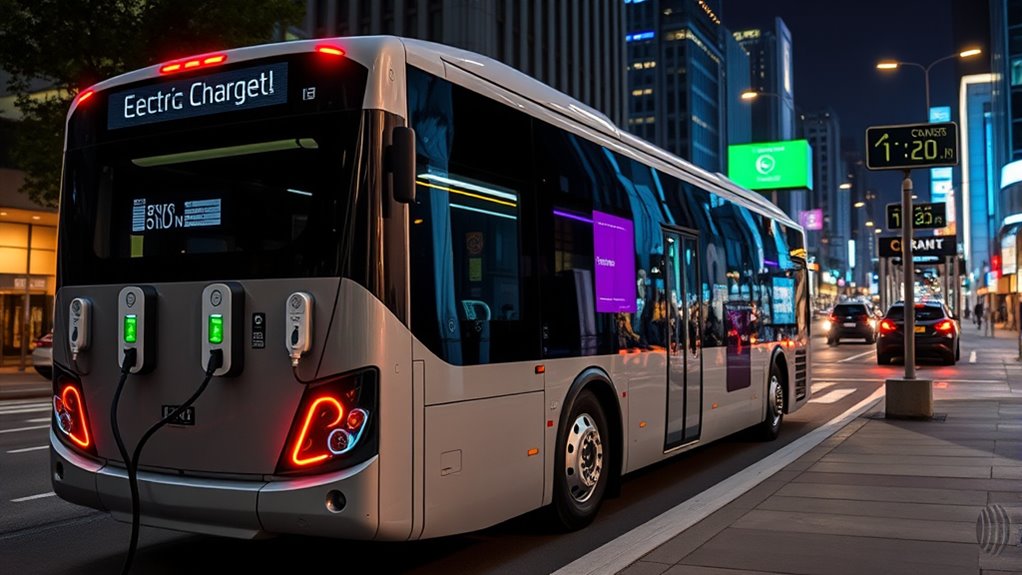
Maximizing the performance and reliability of your charging stations requires implementing targeted strategies that optimize both energy use and operational efficiency. Start with ideal charging strategies like partial charging, which saves time and resources, and manage charging times carefully to reduce downtime.
Optimize charging efficiency with strategic partial charging and careful timing to boost performance and reliability.
Controlling charge power ensures batteries accept energy efficiently, while analyzing vehicle flow helps distribute demand effectively. Seasonal adjustments, such as adapting to temperature changes, can boost battery performance.
Ensure charger configurations match battery needs, and locate fast-charging stations strategically to improve efficiency and cut costs. Proper capacity planning prevents overloading, maintaining system reliability.
Finally, implement power matching between chargers and batteries to optimize charging performance, ensuring your infrastructure runs smoothly and consistently.
Integrating New Charging Infrastructure With Existing Systems
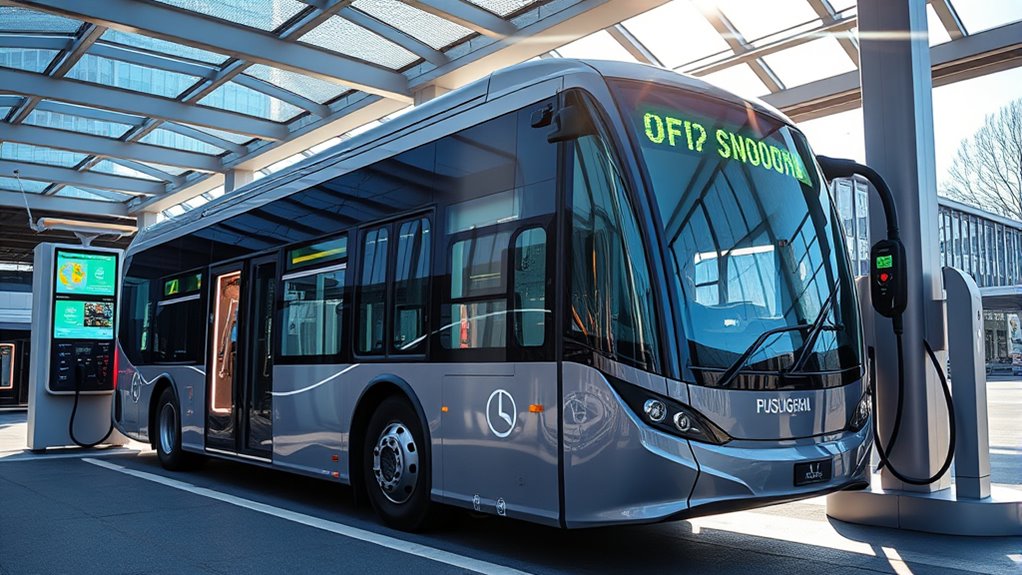
Integrating new charging infrastructure with existing systems requires careful coordination between utility providers and your organization’s planning efforts. You should work early with utilities to guarantee system compatibility and meet regulatory standards. Proper planning ensures compatibility, prevents overloads, and optimizes load management. Additionally, understanding regulatory compliance challenges can help avoid legal issues and streamline the integration process. Utility-side infrastructure, like line extensions and grid upgrades, may be funded through utility programs or shared costs, while your organization often handles onsite equipment such as transformers and switchgear. For large fleets, primary service options allow you to own high-voltage infrastructure, bypassing standard limitations. Considering self-understanding and personal strengths can also assist in managing complex projects effectively. Recognizing how creativity can facilitate problem-solving during integration can lead to more innovative solutions. Cost-sharing models vary, with some utilities offering rebates or grants.
Key Factors to Consider When Selecting a Charging Location
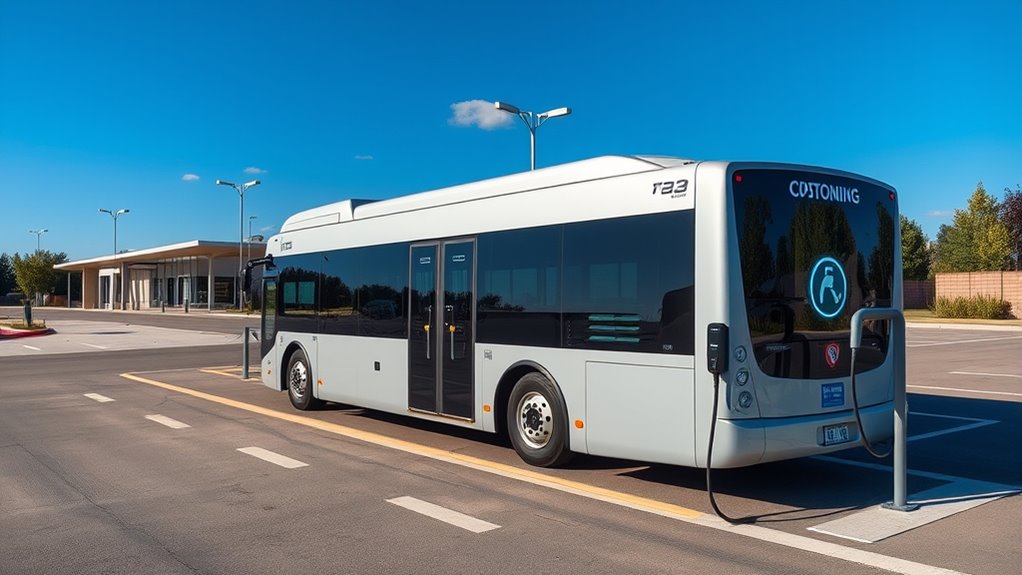
Choosing the right location for your charging stations is essential to guarantee efficient operation and cost savings. You need to take into account your fleet’s power requirements—whether your buses need Level 2 AC or fast DC charging—and ensure the site can support these demands. Proper assessment of the electrical infrastructure can help prevent unexpected expenses and delays. Assess the available electrical infrastructure and grid capacity to avoid costly upgrades or peak demand charges. Facility layout matters; place chargers where buses can access easily with minimal disruption. Think about charging windows—overnight or mid-day—and whether multiple units are necessary. Space constraints may require phased installations or multi-port chargers. Additionally, consider operational simplicity—using one charger per bus can streamline processes. Incorporating data-driven strategies can optimize your charging schedules and improve overall efficiency. Staying informed about AI-driven solutions in energy management can further enhance your operational planning. Finally, evaluate options like turnkey solutions or outsourced services to minimize upfront costs and management burdens. Understanding relationships within your team can also improve coordination and scheduling for charging times.
Frequently Asked Questions
How Do I Estimate the Total Cost of Installing a Charging Station?
To estimate the total cost of installing a charging station, you should consider the charger type and power output, site preparation, and necessary infrastructure upgrades.
Factor in permit and regulatory costs, which vary by location.
Don’t forget additional expenses for bus-specific infrastructure and operational adjustments.
What Grants or Incentives Are Available for Electric Bus Charging Infrastructure?
Are you aware of the funding opportunities available for electric bus charging infrastructure? You can tap into federal programs like the NEVI Formula Program, offering $5 billion for highway charging networks, and the Discretionary Grant Program for additional support.
California provides incentives through the HVIP’s ZESBI Program and PG&E offers per-vehicle rebates. These grants target underserved areas and promote sustainable, accessible charging solutions for your electric bus fleet.
How Can I Ensure My Charging Station Remains Operational During Power Outages?
To keep your charging station operational during power outages, you should install onsite backup solutions like dispatchable generators and energy storage systems.
Use redundant, modular chargers at multiple depots and guarantee critical systems have UPS support.
Collaborate with utilities for grid upgrades and adopt managed charging strategies to prevent overloads.
Regularly train staff on manual overrides and conduct resilience drills, so you’re prepared to maintain charging during emergencies.
What Training Is Needed for Staff to Operate and Maintain Charging Stations?
You need to guarantee your staff has proper training to operate and maintain charging stations. This includes safety procedures, troubleshooting, and repair skills, especially for high-voltage systems.
Technicians should pursue certifications like HV3, and support staff should learn safe charging practices.
Continuous education keeps everyone up-to-date with new technology. Well-trained staff can keep charging stations running smoothly, preventing downtime and ensuring reliable bus operations.
How Do I Future-Proof My Charging Infrastructure for Fleet Expansion?
You face a future filled with uncertainty yet opportunity. To future-proof your charging infrastructure, prioritize interoperability, scalability, and modular design, so your system adapts effortlessly to fleet growth.
Choose sites with expansion potential, plan power supply needs, and incorporate fast-charging options.
Embrace smart algorithms and energy storage to stay efficient.
Conclusion
So, after all this, finding the perfect charging station might seem straightforward—until you realize it’s not. You’ll plan, assess, and strategize, only to discover that the ideal spot is often hidden behind zoning laws or budget constraints. Ironically, your biggest challenge isn’t technology but steering through the complexities of location and infrastructure. But hey, with patience and persistence, you’ll eventually find that sweet spot—just don’t forget your map.
